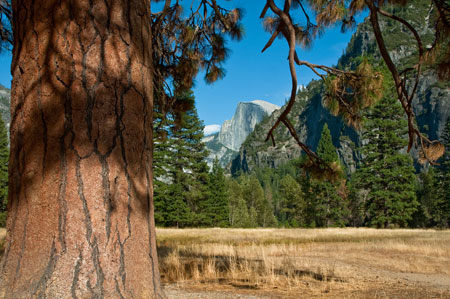By Michelle Werts

Here at American Forests, we love big trees — as is evident by our 70-plus-year-old National Big Tree Program. We love big trees for a variety of reasons, like their size and the histories they tell, but perhaps the biggest reason is the most hidden of all: They’re good for our forests.
A study released this week in the online science journal PloS ONE reveals the exact extent of big trees’ impact on their ecosystems. It turns out that trees three-plus feet in diameter account for almost half of the biomass in the 63-acre section in Yosemite National Park that was studied, but are only one percent of the trees growing there. Now, what does this mean to those of us who didn’t major in ecology? Well, ecosystems at their most basic level are comprised of living (plants, animals, organisms) and non-living things (air, sunlight, minerals). Biomass represents the living side of that equation; all of the things that are alive and kicking (or were recently alive and kicking) make up an ecosystem’s biomass. So back to that conclusion earlier, if you had a forest area of 100,000 trees, just 1,000 big trees in that area would be responsible for 50 percent of the area’s biomass. That’s just crazy, right?
Actually, not so crazy.
Let’s start with the trees themselves. They’re big, so they take in more light than other trees nearby, which means more photosynthesis, carbon sequestration, transpiration (the absorption and dispersal of water through their roots and leaves) and other activities. When you combine all of these activities, the big trees actually can form their own microclimate. Then, there are the animals that love to use these big trees as their homes, burrowing into their trunks and making nests in their canopies — plus, the animals that use the trees for food. And, then there are all of the insects and microscopic organisms that feast on and around these trees. Basically, the bigger the tree, the more living things that can flock to it.

But, this alone isn’t what accounts for big trees’ 50 percent of the biomass — they contribute in death, too. When any tree falls in the forest, it becomes a woody haven for the earthbound organisms of the forest, and the bigger the tree, the more it can support. Plants and trees can grow from fallen trunks. Even animal species that won’t set foot in a big tree’s canopy can find comfy digs in it once it’s on the ground. And, of course, they continue to store carbon and nutrients, as they slowly release them back into the environment.
Basically, a big tree is a big deal to life in at least temperate forests, where this study was conducted. Which means, big trees — and conversely, old trees since you can’t get big without some years on you — need to be protected. This also calls into question the paradigm for many development projects: cutting down a tree even if you’re going to plant a new tree in its place does not an even exchange make. As this study shows, we lose a whole lot more than one tree when old, big trees are lost. That’s why we’re fighting the good fight and honor our big trees every year with our National Register of Big Trees so that the biggest trees in the country can be recognized and appreciated for the value they provide.